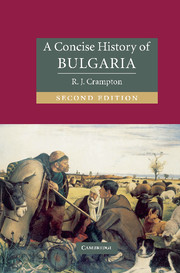Book contents
- Frontmatter
- Contents
- List of illustrations
- Preface
- Preface to the second edition
- Note on transliteration
- The Bulgarian lands: main rivers and mountains
- 1 THE BULGARIAN LANDS FROM PREHISTORY TO THE ARRIVAL OF THE BULGARIANS
- 2 MEDIAEVAL BULGARIA, 681–1393
- 3 OTTOMAN RULE IN THE BULGARIAN LANDS
- 4 THE NATIONAL REVIVAL AND THE LIBERATION
- 5 THE CONSOLIDATION OF THE BULGARIAN STATE, 1878–1896
- 6 FERDINAND'S PERSONAL RULE, 1896–1918
- 7 BULGARIA, 1918–1944
- 8 BULGARIA UNDER COMMUNIST RULE, 1944–1989
- 9 POST-COMMUNIST BULGARIA
- CONCLUSION
- Appendix 1 Bulgarian monarchs
- Appendix 2 Prime ministers of Bulgaria, 1879–2004
- Suggestions for further reading
- Index
- CAMBRIDGE CONCISE HISTORIES
6 - FERDINAND'S PERSONAL RULE, 1896–1918
Published online by Cambridge University Press: 05 June 2012
- Frontmatter
- Contents
- List of illustrations
- Preface
- Preface to the second edition
- Note on transliteration
- The Bulgarian lands: main rivers and mountains
- 1 THE BULGARIAN LANDS FROM PREHISTORY TO THE ARRIVAL OF THE BULGARIANS
- 2 MEDIAEVAL BULGARIA, 681–1393
- 3 OTTOMAN RULE IN THE BULGARIAN LANDS
- 4 THE NATIONAL REVIVAL AND THE LIBERATION
- 5 THE CONSOLIDATION OF THE BULGARIAN STATE, 1878–1896
- 6 FERDINAND'S PERSONAL RULE, 1896–1918
- 7 BULGARIA, 1918–1944
- 8 BULGARIA UNDER COMMUNIST RULE, 1944–1989
- 9 POST-COMMUNIST BULGARIA
- CONCLUSION
- Appendix 1 Bulgarian monarchs
- Appendix 2 Prime ministers of Bulgaria, 1879–2004
- Suggestions for further reading
- Index
- CAMBRIDGE CONCISE HISTORIES
Summary
STOILOV'S PROGRAMME FOR MODERNISATION
Because the early liberal governments had been preoccupied with constitutional issues and Stambolov's first concern always had to be internal security, it was not really until the Stoilov administration came to power that a systematic attempt to develop the Bulgarian economy could be made. Stoilov, who had once declared that he wished to make Bulgaria ‘the Belgium of the Balkans’, was eager for the task. In 1894 his government passed the encouragement of industry bill. Industries which were included within one of nine defined categories and which had capital of 25,000 leva and at least 20 employees were to receive state encouragement; the chief beneficiaries were mining and metallurgy, textiles and the construction industry. State encouragement was to take the form of free grants of land for factory building together with financial help for the construction of any necessary road or rail links, preferential rates on the state railways for finished products, free use of state or local authority quarries and water power, tax advantages, preference in the awarding of state contracts even if the native products were more expensive than imported ones, and a monopoly in supplying certain items within specified geographic limits. Further acts in 1905 and 1909 both widened the scope of industries eligible for encouragement and lowered the qualifications necessary to receive it.
If home industries were to be stimulated, however, they would need protection from cheap western imports.
- Type
- Chapter
- Information
- A Concise History of Bulgaria , pp. 117 - 143Publisher: Cambridge University PressPrint publication year: 2005

